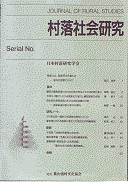1 巻, 2 号
選択された号の論文の9件中1~9を表示しています
- |<
- <
- 1
- >
- >|
論文
-
1995 年 1 巻 2 号 p. 1-7
発行日: 1995年
公開日: 2013/02/26
PDF形式でダウンロード (5806K) -
1995 年 1 巻 2 号 p. 8-18
発行日: 1995年
公開日: 2013/02/26
PDF形式でダウンロード (9844K) -
1995 年 1 巻 2 号 p. 19-29
発行日: 1995年
公開日: 2013/02/26
PDF形式でダウンロード (8949K) -
1995 年 1 巻 2 号 p. 30-40
発行日: 1995年
公開日: 2013/02/26
PDF形式でダウンロード (9172K)
研究ノート
-
1995 年 1 巻 2 号 p. 41-52
発行日: 1995年
公開日: 2013/02/26
PDF形式でダウンロード (9413K)
書評
-
1995 年 1 巻 2 号 p. 53-54
発行日: 1995年
公開日: 2013/02/26
PDF形式でダウンロード (1657K) -
1995 年 1 巻 2 号 p. 55-56
発行日: 1995年
公開日: 2013/02/26
PDF形式でダウンロード (1609K) -
1995 年 1 巻 2 号 p. 57-58
発行日: 1995年
公開日: 2013/02/26
PDF形式でダウンロード (1877K) -
1995 年 1 巻 2 号 p. 59-60
発行日: 1995年
公開日: 2013/02/26
PDF形式でダウンロード (1651K)
- |<
- <
- 1
- >
- >|
